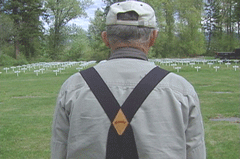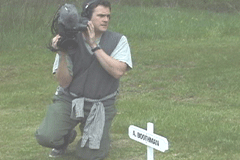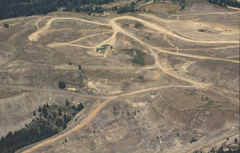Libby, Montana
Air Date: Week of August 17, 2007

Libby resident, Bob Dedrick, looks out over the crosses displayed in 2002 at the community cemetery in honor of the known Libby asbestos victims. (A scene from “Libby, MT”)
In the small town of Libby, Montana, more than a thousand people have been diagnosed with lung disease and over 200 have died from exposure to vermiculite, a type of asbestos used for insulation in homes. The contaminated town became a Superfund site and executives from W.R. Grace, the company that owned the vermiculite mine, will soon go to trial on charges they covered up the extent of asbestos contamination in Libby and obstructed regulators from investigating. Host Steve Curwood talks with Drury Gunn Carr who co-directed a documentary on Libby, Montana, which will soon air on PBS’ POV series.
Transcript
CURWOOD: It’s Living on Earth. I’m Steve Curwood. A hundred years ago Libby, Montana was like so many other small towns in the American West. Its population grew to about 2700 as people came to work the timber and mining industries. And it looked like Libby had a bright future as it began mining what was branded as zonolite, a form of vermiculite that would be used as home insulation and fertilizer around the world. But as the years wore on, the mining company realized that its product was laced with tremolite, a type of asbestos that is particularly hazardous to health. And instead of warning its workforce of the dangers, it kept on mining. The story of Libby, Montana is the subject of a documentary film on the POV series on PBS, which airs August 28th. Drury Gunn Carr and Doug Hawes-Davis co-directed the film. I asked Dru to tell me what happens to people who are exposed to this mineral?
GUNN-CARR: What happens is this tremolite gets stirred up in the air during mining or in any kind of agitation and people breathe it in, and over time it starts to scar the lungs and turns into a disease called asbestosis. What happens is the lungs fill up with water essentially and they suffocate over time. So the other disease associated with it, two diseases, one is lung cancer and the other one is called mesothelioma, which is a very rare cancer of the outer lining of the lungs.
CURWOOD: I’d like to play some sound from your documentary now from an interview with a man named Les Skramstad who worked in the vermiculite mine. It was his first day on the job and he was excited about the opportunity he told you.

Director, Dru Gunn-Carr, shooting in Libby, Montana.(A scene from “Libby, MT”)
CURWOOD: So Les Skramstad takes this job at the plant and what happens to him and his health?
GUNN-CARR: Well, over time he started to develop a cough and had trouble breathing. And he went to the hospital and was told that he had asbestosis and that he had just a few years to live.
SKRAMSTAD: So, I went out and got in the car and started for home and I suppose, I guess we got about half way home probably, and I said to Norita, I said “Jesus you know what?” And she said, “what” I said, “I just got a death sentence.”
CURWOOD: What did he do about the fact that he had this disease from working at the mine?
GUNN-CARR: Well, Les was a very soft-spoken man and I think he probably found it difficult to speak out about his ailment. And Les was told by many that he was a troublemaker, that he was a reactionary and a radical. All those terms were used to describe anyone who came out and said “We have a problem in this town people are getting sick.”
CURWOOD: So, did he remain ostracized for the rest of his life?
GUNN-CARR: Well, no he didn’t. Les continued over the years to speak out publicly along with a handful of other people. And as the numbers of people being diagnosed with asbestosis in that town grew, the call for action also grew. Les passed away in January of this year, 2007. And it was very heartening to go to his funeral and see the hundreds of people who came in literally blizzard conditions to pay their respects.
CURWOOD: This is a town of what, about 2700 people and of this town, do I have this correct, more than 200 have died from lung disease and another 1200 have some form of lung disease?

Libby resident, Bob Dedrick, looks out over the crosses displayed in 2002 at the community cemetery in honor of the known Libby asbestos victims.
(A scene from “Libby, MT”)
GUNN-CARR: Yeah, it’s hard to get around those numbers. There’s now a clinic set up in Libby called the Center for Asbestos Related Disease and they report that they have something on the order of 1400 patients with some type of lung abnormality associated with asbestos exposure. And they estimate that around 270 people have died from asbestos-related disease.
CURWOOD: W.R. Grace was the company that was doing the mining in Libby, Montana can you tell me a bit about this company?
GUNN-CARR: Well, W.R. Grace has been around for a long time. They are a huge multinational corporation. You know W.R. Grace is one of the companies that was involved in the Woburn, Massachusetts lawsuits which ended up in the book and the film “A Civil Action”. So, they’re not unknown to be in issues associated with toxic material. And in the case of Libby, the on-scene coordinator for the EPA, Paul Peronard described Grace as being by far the most difficult corporation to work with. And that has been shown to be the case in Libby, where many people feel that they were betrayed by this company.
CURWOOD: What will happen and what has happened to W.R. Grace and its former employees?

Abandoned WR Grace vermiculite mine near Libby, Montana. (A scene from “Libby, MT”)
CURWOOD: What about criminal sanctions? Executives were indicted, as I understand it at some point. What’s happened in those cases?
GUNN-CARR: Yeah, it’s been ongoing for a couple of years now but in February of 2005, seven executives and managers from W. R. Grace were indicted on federal criminal charges for knowingly endangering the residents of Libby and concealing information about the health effects of its mining operations. And that case is due to come up in September of 2007, but it’s far from clear that any of these charges will stick.
CURWOOD: So, what’s the prospect for Libby ever getting all of this stuff cleaned up?
GUNN-CARR: Well, that’s the question and early in 2007 that’s exactly what EPA is doing. They’re doing a huge study to determine how clean the town needs to be in order to significantly reduce the risk of asbestos exposure.
CURWOOD: This asbestos-laced vermiculite was shipped all over the country to be used as insulation. How many homes do you think it’s in today?
GUNN-CARR: Well, that’s the big question. The Environmental Protection Agency estimates that somewhere around 35 million homes and buildings have some level of zonolite insulation from Libby. The question now is, ‘Is it safe to have zonolite insulation in your home if it’s sealed up?’ and that’s a question that the EPA has really failed to answer. One of the reasons that Libby for instance was never declared an emergency, was because if they did that they would have had to have taken out all the insulation from all the homes in Libby. But of course the problem with that is that if they did that they’d have to explain to the American public why they aren’t addressing zonolite insulation in all of these millions and millions of homes throughout the United States.
CURWOOD: Drury Gunn Carr and his partner Doug Hawes-Davis produced the documentary film, Libby Montana for the Point of View series on PBS that airs August 28th. Thank you so much sir.
CARR: Thank you.
[MUSIC: Bask “Hebyhalling” from ‘Bask’ (MNW Records Group – 1999)]
Links
Living on Earth wants to hear from you!
Living on Earth
62 Calef Highway, Suite 212
Lee, NH 03861
Telephone: 617-287-4121
E-mail: comments@loe.org
Newsletter [Click here]
Donate to Living on Earth!
Living on Earth is an independent media program and relies entirely on contributions from listeners and institutions supporting public service. Please donate now to preserve an independent environmental voice.
NewsletterLiving on Earth offers a weekly delivery of the show's rundown to your mailbox. Sign up for our newsletter today!
 Sailors For The Sea: Be the change you want to sea.
Sailors For The Sea: Be the change you want to sea.
 The Grantham Foundation for the Protection of the Environment: Committed to protecting and improving the health of the global environment.
The Grantham Foundation for the Protection of the Environment: Committed to protecting and improving the health of the global environment.
 Contribute to Living on Earth and receive, as our gift to you, an archival print of one of Mark Seth Lender's extraordinary wildlife photographs. Follow the link to see Mark's current collection of photographs.
Contribute to Living on Earth and receive, as our gift to you, an archival print of one of Mark Seth Lender's extraordinary wildlife photographs. Follow the link to see Mark's current collection of photographs.
 Buy a signed copy of Mark Seth Lender's book Smeagull the Seagull & support Living on Earth
Buy a signed copy of Mark Seth Lender's book Smeagull the Seagull & support Living on Earth

